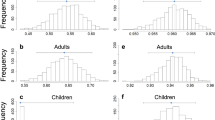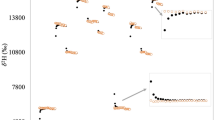Abstract
Obesity is defined as the excess storage of energy in the form of fat that results from imbalances between energy intake and expenditure. The study of the components of energy balance has undergone a significant advancement with the application of the doubly labeled water (DLW) method to the measurement of human energy expenditure. This manuscript includes a selective review of the studies that have utilized the doubly labeled method as it applies to the study of human obesity. Although generally now accepted, one of the major surprises from the early applications of DLW was that obese individuals have higher energy expenditures than lean controls. Moreover, weight gain, even in the already obese, is associated with an increase in energy expenditure as weight is one of the strongest predictors of total energy expenditure. Similarly, studies of weight loss treatment show a decrease in energy expenditure due to weight loss and due to adaptive changes in energetic efficiency, but these changes do not account for the common cessation of weight loss observed after 12–26 weeks of restriction. The accumulating data from the application of the DLW method suggest a need to place greater emphasis on mechanisms that lead to a mismatch between energy intake and expenditure rather than a continuing emphasis on energy intake or energy expenditure alone.
This is a preview of subscription content, access via your institution
Access options
Subscribe to this journal
Receive 12 print issues and online access
$259.00 per year
only $21.58 per issue
Buy this article
- Purchase on Springer Link
- Instant access to full article PDF
Prices may be subject to local taxes which are calculated during checkout

Similar content being viewed by others
References
Webb P, Annis JF, Troutman Jr SJ . Energy balance in man measured by direct and indirect calorimetry. Am J Clin Nutr 1980; 33: 1287–1298.
Ogden CL, Fryar CD, Carroll MD, Flegal KM . Mean body weight, height, and body mass index, United States 1960–2002. Adv Data 2004; 347: 1–17.
Webb P . The exchange of matter and energy in lean and overweight men and women: a calorimetric study of overeating, balanced intake and undereating. Int J Obes 1985; 9 (Suppl 2): 139–145.
Lifson N, Gordon GB, Mcclintock R . Measurement of total carbon dioxide production by means of D2O18. J Appl Physiol 1955; 7: 704–710.
Schoeller DA, van Santen E . Measurement of energy expenditure in humans by doubly labeled water method. J Appl Physiol 1982; 53: 955–959.
Lifson N . Theory of use of the turnover rates of body water for measuring energy and material balance. J Theor Biol 1966; 12: 46–74.
Nagy KA . Field metabolic rate and body size. J Exp Biol 2005; 208: 1621–1625.
Prentice AM (ed). The Doubly Labeled Water Method for Measuring Energy Expenditure; Technical Recommendations for Use in Humans. A Consensus Report by the IDECG Working Group. International Atomic Energy Agency: Vienna, 1990.
Prentice AM, Black AE, Coward WA, Davies HL, Goldberg GR, Murgatroyd PR et al. High levels of energy expenditure in obese women. Br Med J (Clin Res Ed) 1986; 292: 983–987.
Bandini LG, Schoeller DA, Dietz WH . Energy expenditure in obese and nonobese adolescents. Pediatr Res 1990; 27: 198–203.
Schulz LO, Schoeller DA . A compilation of total daily energy expenditures and body weights in healthy adults. Am J Clin Nutr 1994; 60: 676–681.
Das SK, Saltzman E, McCrory MA, Hsu LK, Shikora SA, Dolnikowski G et al. Energy expenditure is very high in extremely obese women. J Nutr 2004; 134: 1412–1416.
Dietary Reference Intakes for Energy, Carbohydrate, Fiber, Fat, Fatty Acids, Cholesterol, Protein, And Amino Acids, Institute of Medicine. The National Academies Press: Washington, DC, 2002.
Roberts SB, Savage J, Coward WA, Chew B, Lucas A . Energy expenditure and intake in infants born to lean and overweight mothers. N Engl J Med 1988; 318: 461–466.
Roberts SB . Early diet and obesity. In: Heird W (ed). Nutritional Needs of the Six to Twelve Month Infant. Raven Press: New York, 1991, pp 303–316.
Stunkard AJ, Berkowitz RI, Stallings VA, Schoeller DA . Energy intake, not energy output, is a determinant of body size in infants. Am J Clin Nutr 1999; 69: 524–530.
Stunkard AJ, Berkowitz RI, Schoeller D, Maislin G, Stallings VA . Predictors of body size in the first 2 y of life: a high-risk study of human obesity. Int J Obes Relat Metab Disord 2004; 28: 503–513.
Goran MI, Shewchuk R, Gower BA, Nagy TR, Carpenter WH, Johnson RK . Longitudinal changes in fatness in white children: no effect of childhood energy expenditure. Am J Clin Nutr 1998; 67: 309–316.
DeLany JP, Bray GA, Harsha DW, Volaufova J . Energy expenditure and substrate oxidation predict changes in body fat in children. Am J Clin Nutr 2006; 84: 862–870.
Luke A, Durazo-Arvizu RA, Cao G, Forrester TE, Wilks RJ, Schoeller DA et al. Activity, adiposity and weight change in Jamaican adults. West Indian Med J 2007; 56: 398–403.
Schoeller DA, Shay K, Kushner RF . How much physical activity is needed to minimize weight gain in previously obese women? Am J Clin Nutr 1997; 66: 551–556.
Weinsier RL, Hunter GR, Desmond RA, Byrne NM, Zuckerman PA, Darnell BE . Free-living activity energy expenditure in women successful and unsuccessful at maintaining a normal body weight. Am J Clin Nutr 2002; 75: 499–504.
Catenacci VA, Ogden LG, Stuht J, Phelan S, Wing RR, Hill JO et al. Physical activity patterns in the National Weight Control Registry. Obesity (Silver Spring) 2008; 16: 153–161.
Franz MJ, VanWormer JJ, Crain AL, Boucher JL, Histon T, Caplan W et al. Weight-loss outcomes: a systematic review and meta-analysis of weight-loss clinical trials with a minimum 1-year follow-up. J Am Diet Assoc 2007; 107: 1755–1767.
Keys A, Brozek J, Henschel A, Mickelsen O, Taylor HL . The Biology of Human Starvation (2 volumes). University of Minnesota Press: Minneapolis, 1950.
Rosenbaum M, Nicolson M, Hirsch J, Murphy E, Chu F, Leibel RL . Effects of weight change on plasma leptin concentrations and energy expenditure. J Clin Endocrinol Metab 1997; 82: 3647–3654.
Martin CK, Heilbronn LK, de Jonge L, DeLany JP, Volaufova J, Anton SD et al. Effect of calorie restriction on resting metabolic rate and spontaneous physical activity. Obesity (Silver Spring) 2007; 15: 2964–2973.
Heymsfield SB, Harp JB, Reitman ML, Beetsch JW, Schoeller DA, Erondu N et al. Why do obese patients not lose more weight when treated with low-calorie diets? A mechanistic perspective. Am J Clin Nutr 2007; 85: 346–354.
Racette SB, Schoeller DA, Kushner RF, Neil KM . Exercise enhances dietary compliance during moderate energy restriction in obese women. Am J Clin Nutr 1995; 62: 345–349.
Kempen KP, Saris WH, Westerterp KR . Energy balance during an 8-wk energy-restricted diet with and without exercise in obese women. Am J Clin Nutr 1995; 62: 722–729.
Votruba SB, Blanc S, Schoeller DA . Pattern and cost of weight gain in previously obese women. Am J Physiol Endocrinol Metab 2002; 282: E923–E930.
Yanovski JA, Yanovski SZ, Sovik KN, Nguyen TT, O’Neil PM, Sebring NG . A prospective study of holiday weight gain. N Engl J Med 2000; 342: 861–867.
Shepard TY, Weil KM, Sharp TA, Grunwald GK, Bell ML, Hill JO et al. Occasional physical inactivity combined with a high-fat diet may be important in the development and maintenance of obesity in human subjects. Am J Clin Nutr 2001; 73: 703–708.
Butte NF, Christiansen E, Sørensen TI . Energy imbalance underlying the development of childhood obesity. Obesity (Silver Spring) 2007; 15: 3056–3066.
Flatt JP . How NOT to approach the obesity problem. Obes Res 1997; 5: 632–633.
Acknowledgements
I would like to thank the many collaborators, students and staff who have contributed to the development of the DLW method for human studies and its application to the study of obesity.
Author information
Authors and Affiliations
Corresponding author
Additional information
Conflict of interest
Dale A Schoeller has recently held grants from Dairy Management Inc., Cognis GMBH, Lipid Nutrition, ImpediMed, and Picarro, Inc.
Rights and permissions
About this article
Cite this article
Schoeller, D. Insights into energy balance from doubly labeled water. Int J Obes 32 (Suppl 7), S72–S75 (2008). https://doi.org/10.1038/ijo.2008.241
Published:
Issue Date:
DOI: https://doi.org/10.1038/ijo.2008.241



